#viparita virabhadrasana
Photo
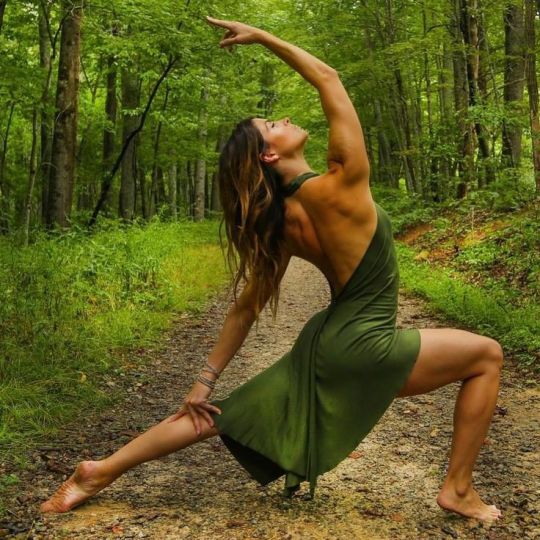
(via Robert Sturman (@robertsturman) • Instagram photos and videos | Photoshoot, Instagram photo, Photo and video || Curated with love by yogadaily)
#viparita virabhadrasana#woods#yoga in the woods#yoga#yogi#yogini#asana#asanas#yoga pose#yoga poses#yoga posture#fitness#health and fitness#manifestation#manifest#manifesting#yoga inspiration#inspiration#inspire#inspirational#yoga motivation#yoga aesthetic#aesthetic#yoga daily
315 notes
·
View notes
Text
The Viparita Virabhadrasana, also known as Reverse Warrior Pose, stretches your groins, hips, obliques, and opens your heart and throat chakras. The expert believes that practicing this pose can release tension in the muscles around the ribs to create a deeper, freer breath. It energizes the body and improves self-esteem and perseverance.
🔸 🔸 🔸 🔸 🔸 🔸 🔸 🔸 🔸 🔸
🧘♂️ Information:👉
1️⃣ Known as:👉 Viparita Virabhadrasana, Reverse Warrior Pose, Urdhva Virabhadrasana, Peaceful Warrior Pose
2️⃣ Sanskrit name:👉 विपरीत वीरभद्रासन
3️⃣ IAST:👉 Viparīta Vīrabhadrāsana
4️⃣ Pronunciation:👉 VIP-uh-REE-tuh veer-uh-buh-DRAHS-uh-nuh
5️⃣ Type:👉 Standing, back-band, side-bending, balance
6️⃣ Level:👉 Beginner
7️⃣ Focus:👉 Neck, shoulder, knees, hip flexors, pelvic muscles, thighs, glutes, hamstring, lower back
8️⃣ Total time:👉 30 to 60 seconds
9️⃣ Drishti:👉 Urdhva or Antara Drishti (up to the sky)
🔟 Chakra:👉 Manipura Chakra, Swadisthana Chakra, Muladhara Chakra
💡 Indications:👉 Respiration, stress, anxiety, depression, cortisol
💡 Counterposes:👉 Utthita Parsvakonasana (Extended Side Angle Pose), Prosarita Padotanasana (Wide-legged Forward Fold Pose), Uttanasana (Standing Forward Fold Pose)
💡 Preparatory poses:👉 Virabhadrasana II (Warrior Pose II), Utthita Parsvakonasana (Extended Side Angle Pose), Parivrtta Janu Sirsasana (Revolved Head-to-knee Pose)
💡 Follow-up pose:👉 Utthita Trikonasana (Extended Triangle Pose), Parivrtta Surya Yantrasana (Seated Compass Pose), Anjaneyasana (Monkey Lunge Pose)
💡 Contraindications:👉 High blood pressure or low blood pressure, vertigo, dizziness, migraine, or headache, diarrhea, knee arthritis, cervical spondylitis, slip disc, disc bulge, herniated disc
🔸🔸🔸🔸🔸🔸🔸🔸🔸🔸
#yoga poses#Fitzabout#Fitabouts#Viparita Virabhadrasana#Reverse Warrior Pose#Urdvha Virabhadrasana#Peaceful warrior pose
1 note
·
View note
Text
Prenatal Yoga: A Comprehensive Guide for Expectant Mothers
Pregnancy is a transformative and beautiful journey, but it can also come with physical and emotional challenges. Staying active and taking care of your body is crucial during this time, and one activity that can provide numerous benefits is prenatal yoga.
In this comprehensive guide, we will explore the world of prenatal yoga, including its benefits, safety considerations, and recommended poses…
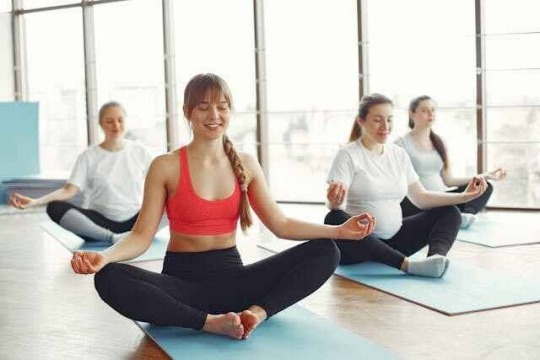
View On WordPress
#Baddha Konasana#Cobbler&039;s Pose#Expectant Mother#Gate Pose#Legs-Up-the-Wall#Parighasana#Pregnancy#Pregnancy Yoga#prenatal yoga#Prenatal Yoga Tips for Each Trimester#Viparita Karani#Virabhadrasana II#Warrior II#When should you start prenatal yoga?#Which yoga is best for pregnancy?#Yoga#Yoga for Pregnant Women#Yoga in Pregnancy
1 note
·
View note
Text
practice makes better
Pairing: Finan x reader x Sihtric
Warnings: none really; some sexual innuendos, but nothing explicit.
Word Count: 950 - a solid drabble for my first time back in fucking ages
A/N: This is a timestamp for the lost-in-time!reader series by @anotherwinchesterfangirl, where our pieces fall into place. I bullied her into writing it for me because I don’t write anymore. And then I got an itch I needed to scratch. I imagine this is a few weeks into the relationship, still summer months because the weather remains warm enough to allow early mornings outside.
A/N 2: I also tried my very beginner’s hand at a few mood boards to show you some of the yoga poses described. Please be gentle with me. If you can’t find them in the story, I’ve linked ‘em at the end.

The very first time Finan and Sihtric interrupted your practice, they came upon you already in svasana.
Your hips were heavy against the ground and legs splayed in a narrow vee, the soles of your feet soft and rolling outward. With each easy breath in you felt your collar bones widen, and with each exhale you drew your shoulder blades down and willed your back body to spread out against the ground. Your hands lay flat on the fabric beneath you, palms open to the sky ready to receive the gifts of the day.
You actually welcomed the rustle of footsteps in the tall grass since you no longer had anyone to count you out of the meditative rest.
"Are ye alrigh’?"
You blinked an eye open to take in Finan's concerned visage and assumed they must have finished their morning routine early before joining you for a picnic breakfast in the secluded hilltop field you'd found on a stroll outside of town.
"Or did we wear you out last night?" Sihtric grinned down as you opened another eye and shifted your gaze with a matching smile.
"I was just resting while I waited for you." They each clasped an offered arm and helped you to sit up before joining you down on the blanket.
"I dare say we did, Sihtric.” Finan popped a grape between his smirking lips.
You cherished this time in the early morning before you figured out how to make yourself useful to the town. Upon discovering you did more in that field than rest and wait for company, their curiosity couldn't be tamed and they often came upon you in the middle of your practice now.
"And what d'ya call that one move? The one we caught ya in this time," Finan's breath was warm on your neck as you reclined against his chest.
"Viparita Virabhadrasana."
Sihtric quirked an eyebrow as he passed you a piece of fresh bread slathered in honey. You twisted left and raised your arm over your shoulder to offer the first bite to Finan while you translated the Sanskrit for them.
Over the following weeks, Finan would learn to time his arrival. He loved coming over the ridge and finding you in “peaceful warrior”. He never means to intrude but the sight of you sinking into the lunge, bottom arm tracing down your back thigh as you tilted to stretch your top arm toward the open sky makes him ache for you.
"I like it when you fly," Sihtric muses, considering the agility and strength you must possess to then shift forward, straightening your front leg as you lift your back foot off the earth and raise the leg to parallel, arms stretched forward into Virabhadrasana III. It's still a warrior's pose and you smile thinking of how they have both connected to these particular asanas of your made up sequence and how those connections fit each of them perfectly.
What you don't tell them is the English term for Dekasana, the pose you evolve into as you make your way out of warrior III with a sweep of your arms back by your sides, palms down and a gentle lift of your head and chest to mimic up dog. Probably easier to have them believe it was “bird” instead of “airplane”.
It was hard to miss the way they both palmed their semi-hardness through their pants when you stepped back down, legs still spread wide, then turned to the side to face them while they watched your flow. Their jaws dropped a little too as you shifted your feet outward on a diagonal and sank both thighs to parallel.
"Think this is what she meant by 'lapsed Christian'?" Finan teased as you brought your hands first above your head and then down to meet in prayer at your heart for your version of Utkata Konasana.
When you later tell them "goddess", Sihtric huffs a gentle laugh as he brushes his lips across your shoulder and asks, "Are you suuure you're not a Pagan?"
They watch with reverence as you move through your Vinyasa. Up dog, down dog, high plank, low plank. Breath in, breath out, breath in, breath out. Urdhva Mukha Svanasana, arms bent beside you with chest raised and the tops of your bare feet pressing into the earth while your thighs lift just off the ground. Adho Mukha Svanasana, your arms straightening while you roll over your toes and raise your hips behind you, head dropping last. Phalakasana, shifting forward to the tips of your toes, hips dropping in line once again with your shoulders and arms still straight, but soft, easy. Chaturanga, arms bending now close to your sides as you lower your body slowly to hover before shifting on an in breath back to up dog.
The warm mid-summer mornings help ease and stretch your muscles, allowing you to sink deeper into each pose. Before making your way into final rest, you usually choose between straightening a leg one at a time behind you while crossing the other leg bent in front of you and draping your chest over your thigh or dropping down from all fours, knees spread wide and chest moving toward the ground with hips, knees, and ankles all bent at ninety degrees to one another.
Finan and Sihtric are both amazed every time you move into frog, but then again they've always marveled at your flexibility. Luckily you remember just enough of your practice to help keep you limber and ready for them anytime the urge hits and circumstances allow. Private nights, and occasionally days, are always perfect with them, but you’re also happy to practice anything to make it better.
Vinyasa
Vitality/Equanimity
And if I may, a few tags for those who’ve interacted with Liz’s series. Apologies for my boldness and please tell me if you never want this again: @solinarimoon @emilyhufflepufftlk @scarletvhope @filliandkili @unabashedcandymaker @webreathfandoms
#the last kingdom fanfiction#finan x reader x sihtric#finan x reader#sihtric x reader#finan the agile#sihtric kjartansson#tlk fanfic#mine#deandoesthingstome#practice makes better
180 notes
·
View notes
Text
Discover Your Inner Yogi: 31 Essential Poses for Beginners to Practice at Home
Embarking on the path of yoga is a fantastic decision for numerous reasons.
Beyond the physical benefits of increased strength, flexibility, and balance, yoga serves as a powerful tool for stress reduction through specialized breathing techniques known as pranayama.
Yoga is diverse, offering various poses to cater to different needs.
Now, let's delve into the joy of yoga with a focus on 31 essential poses for beginners to practice at home. These foundational poses not only serve as a physical workout but also contribute to mental well-being.
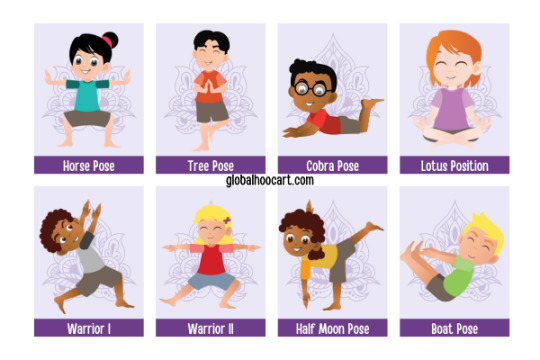
1. Downward Facing Dog (Adho Mukha Svanasana): A classic yoga pose that can be tricky for beginners, emphasizing weight distribution and heel stretching.
2. Mountain Pose (Tadasana): Equally important as Downward Facing Dog, it focuses on alignment, grounding, and spine lengthening.
3. Warrior I (Virabhadrasana I): A standing pose emphasizing forward-facing hips, crucial for building strength.
4. Warrior II (Virabhadrasana II): Similar to Warrior I but with hips facing the side, promoting openness and strength.
5. Extended Side Angle (Utthita Parvakonasana): Involving a modification for beginners, it offers a gentle stretch with forearm support.
6. Triangle Pose (Utthita Trikonasana): Another essential pose, engaging leg strength and enhancing flexibility in multiple areas.
7. Standing Forward Bend (Uttanasana): An easy pose for beginners, promoting spine flexibility and relaxation.
8. Reverse Warrior (Viparita Virabhadrasana): Combining a stance similar to Warrior I with a gentle side bend or backbend.
9. Garland Pose (Malasana): A squatting pose that stretches muscles around the pelvis, beneficial for hip flexibility.
10. Half Forward Bend (Ardha Uttanasana): Also known as Flat-Back Forward Bend, it contributes to improving overall body awareness.
11. Pyramid Pose (Parsvottanasana): A standing forward bend made more accessible for beginners with the use of yoga blocks.
12. Raised Hands Pose (Urdhva Hastasana): Starting from Mountain pose, it offers a full-body stretch, ideal for beginning your practice.
13. Low Lunge: A standing pose emphasizing proper alignment for a beneficial stretch, with modification options for support.
14. Tree Pose (Vrksasana): An excellent introduction to balancing postures, encouraging stability and mindfulness.
15. Downward Facing Dog Split: A basic yoga pose for beginners focusing on core strength and balance.
16. Plank Pose: Not just a balancing pose but a fundamental exercise for building core strength and stability.
17. Cat-Cow Stretch (Chakravakasana): A gentle backbend sequence enhancing body awareness, especially beneficial for beginners or those with back pain.
18. Bridge Pose (Setu Bandha Sarvangasana): A gentle backbend for beginners, enhancing spine extension and countering the effects of prolonged sitting.
19. Cobra Pose (Bhujangasana): A fundamental backbend that strengthens back muscles and promotes flexibility.
20. Knees, Chest, and Chin (Ashtanga Namaskara): An essential part of the sun salutation series, serving as an alternative to Chaturanga Dandasana.
21. Staff Pose (Dandasana): A seated version of Mountain pose, offering alignment guidance for various seated poses.
22. Cobbler's Pose (Baddha Konasana): A comfortable stretch for inner thighs, often using props for support.
23. Easy Pose (Sukhasana): A cross-legged sit made more comfortable with props, promoting flexibility and undoing the effects of prolonged chair sitting.
24. Half Lord of the Fishes Pose (Ardha Matsyendrasana): A seated twist benefiting spinal mobility and aiding digestion.
25. Head to Knee Pose (Janu Sirsasana): Easier than traditional forward bends, offering a gentle stretch one leg at a time.
26. Seated Forward Bend (Paschimottanasana): A fantastic hamstring stretch targeting the entire back of the body.
27. Seated Wide Angle Straddle (Upavistha Konasana): A wide-legged forward bend providing a unique stretch and focusing on proper form.
28. Happy Baby Pose (Ananda Balasana): Balancing effort and ease, this delightful pose offers a gentle stretch for the back, hips, thighs, and ankles.
29. Supine Spinal Twist (Supta Matsyendrasana): A passive twist promoting flexibility, relaxation, and a sense of completion to your practice.
30. Child's Pose (Balasana): A resting pose that allows you to take a break whenever needed, promoting a gentle stretch and relaxation.
31. Corpse Pose (Savasana): A serene conclusion to your session, allowing a smooth transition from the yoga mat to the rest of your day.
In conclusion, these 31 basic yoga poses for beginners at home offer a comprehensive and accessible introduction to the joy of yoga. Remember, yoga is for everyone, and the journey is as important as the destination. Enjoy the practice, embrace self-awareness, and savor the harmonious blend of effort and relaxation that yoga brings to your life.
3 notes
·
View notes
Note
Here’s some all new questions RAYMAN: NYMPHO HYPNO?
1. what is Rayman & Betilla 2nd favorite sex position?
2. What are Rayman & Betilla favorite places to go on their dates?
3. Will Rayman & Betilla go on a double date with Barbara & Ramon in the future?
Viparita Virabhadrasana.
Anywhere in the Glades, really. Preferably near a river.
VERY unlikely.
2 notes
·
View notes
Text
Embracing Aging Gracefully with Baila Rendler: Yoga Practices for Seniors
In the ever-evolving landscape of health and wellness, yoga stands out as a timeless practice that transcends age and fosters holistic well-being. For seniors, yoga offers a gentle yet powerful means of staying active, flexible, and centered as they navigate the journey of aging. In this guide, we explore how seniors can embrace the benefits of yoga to enhance physical strength, mental clarity, and emotional resilience, empowering them to age gracefully and vibrantly.
The Benefits of Yoga for Seniors
Yoga offers a myriad of benefits for seniors, encompassing physical, mental, and emotional aspects of well-being. From improving flexibility and balance to reducing stress and enhancing cognitive function, the practice of yoga nurtures seniors' overall health and vitality. Gentle yoga poses help seniors maintain joint mobility and muscle strength, reducing the risk of falls and enhancing overall mobility. Additionally, yoga's focus on mindfulness and deep breathing promotes relaxation, reduces anxiety, and fosters a sense of inner peace and well-being.
Moreover, regular yoga practice can have profound effects on seniors' mental and emotional health, promoting mental clarity, emotional resilience, and a positive outlook on life. By cultivating mindfulness and self-awareness through yoga as guided by yoga teachers like Baila Rendler, seniors can navigate life's challenges with greater equanimity and grace. Overall, yoga serves as a powerful tool for seniors to enhance their quality of life, promote healthy aging, and cultivate a sense of vitality and joy in their golden years.
Gentle Yoga Poses for Seniors
When practicing yoga, seniors should focus on gentle poses that promote flexibility, strength, and relaxation while minimizing the risk of strain or injury. Standing poses such as Mountain Pose (Tadasana) and Warrior II (Virabhadrasana II) help seniors build strength in the legs and improve balance and stability. Seated poses like Seated Forward Bend (Paschimottanasana) and Cat-Cow Pose (Marjaryasana-Bitilasana) provide gentle stretches for the spine and promote flexibility in the back and hips.
Furthermore, restorative yoga poses such as Supported Child's Pose (Balasana) and Legs-Up-the-Wall Pose (Viparita Karani) offer relaxation and stress relief by encouraging deep breathing and soothing the nervous system. Incorporating a variety of gentle yoga poses into their practice allows seniors to reap the physical and mental benefits of yoga while honoring their bodies' unique needs and limitations. With regular practice, seniors can improve flexibility, mobility, and overall well-being, enabling them to embrace aging with grace and vitality.
Breathing Techniques for Stress Reduction
In addition to yoga poses, seniors can benefit from incorporating yogic breathing techniques, or pranayama, into their practice to promote relaxation and reduce stress. Deep belly breathing, also known as diaphragmatic breathing, involves inhaling deeply through the nose, allowing the belly to expand, and exhaling fully through the mouth. This simple yet effective breathing technique activates the body's relaxation response, calming the nervous system and reducing stress levels.
Furthermore, alternate nostril breathing (Nadi Shodhana) is a balancing pranayama technique that can help seniors find equilibrium and harmony within. By alternating the inhalation and exhalation between the left and right nostrils as guided by yoga teachers like Baila Rendler, this technique balances the flow of energy and clears the mind of mental clutter. Seniors can practice these breathing techniques for a few minutes each day, either as standalone practices or as part of a yoga session, to cultivate a sense of inner calm and tranquility amidst life's challenges.
Mindfulness Meditation for Mental Clarity
Mindfulness meditation is another valuable practice for seniors seeking to enhance mental clarity, focus, and emotional well-being. By cultivating present-moment awareness and non-judgmental observation of thoughts and sensations, mindfulness meditation helps seniors develop resilience and equanimity in the face of life's ups and downs. Simple mindfulness practices, such as body scan meditation or mindful walking, can be incorporated into daily routines to promote a sense of groundedness and connection to the present moment.
Moreover, loving-kindness meditation (Metta Bhavana) fosters feelings of compassion, empathy, and goodwill towards oneself and others. Seniors can practice sending loving-kindness and well-wishes to themselves, loved ones, and even strangers, cultivating a sense of interconnectedness and altruism. By incorporating mindfulness meditation into their daily lives as guided by yoga teachers like Baila Rendler, seniors can cultivate greater emotional resilience, mental clarity, and overall well-being, enabling them to navigate the challenges of aging with grace and wisdom.
Practicing Yoga Safely
When practicing yoga, seniors should prioritize safety and listen to their bodies' cues to prevent injury and ensure a positive experience. It's essential to start slowly, with gentle stretches and movements, gradually increasing intensity and duration as strength and flexibility improve. Seniors should also communicate with their yoga instructor about any physical limitations or health concerns to receive modifications or alternative poses that accommodate their needs.
Additionally, seniors should pay attention to proper alignment and technique during yoga poses to avoid strain or injury. Using props such as blocks, straps, and blankets can provide support and enhance stability, especially for seniors with limited mobility or flexibility. Lastly, seniors should practice self-compassion and mindfulness, honoring their bodies' limitations and avoiding pushing themselves beyond their comfort zone. By practicing yoga mindfully and safely as guided by yoga teachers like Baila Rendler, seniors can maximize the benefits of their practice and enjoy a fulfilling yoga journey for years to come.
Incorporating Yoga into Daily Life
Beyond formal yoga practice sessions, seniors can integrate yoga principles and techniques into their daily lives to promote overall well-being and vitality. Simple practices such as mindful breathing, gentle stretching, and meditation can be incorporated into daily routines, whether it's upon waking in the morning, during breaks throughout the day, or before bedtime to promote relaxation and restful sleep.
Furthermore, seniors can cultivate mindfulness and presence in everyday activities such as walking, eating, and interacting with others, bringing awareness to the present moment and savoring each experience fully. By infusing daily life with the principles of yoga, seniors can enhance their physical health, mental clarity, and emotional resilience, enabling them to embrace aging with grace and vitality. Whether it's taking a mindful walk in nature, practicing deep breathing during stressful moments, or pausing for a moment of gratitude, seniors can harness the transformative power of yoga to enrich their lives and cultivate a sense of well-being at any age.
Yoga offers seniors a holistic approach to maintaining physical health, mental clarity, and emotional well-being as they embrace the journey of aging. Through gentle yoga poses, breathing techniques, and mindfulness practices, seniors can enhance flexibility, strength, and inner peace, enabling them to age gracefully and vibrantly. By incorporating yoga into their daily routines and infusing life with the principles of mindfulness and self-awareness as guided by yoga teachers like Baila Rendler, seniors can cultivate resilience, vitality, and joy in their golden years. As seniors embark on their yoga journey, they discover the transformative power of the practice to nurture the body, mind, and spirit, empowering them to thrive and flourish at every stage of life.
0 notes
Photo

Reverse Warrior Yoga Pose: (Viparita Virabhadrasana) – A Beaut … https://rntozen.com/blog/yoga/reverse-warrior-yoga-pose-viparita-virabhadrasana
#DynamicAsanaPractice#EnergizingWarriorPoses#LateralStretchYoga#ReverseWarriorBenefits#ViparitaVirabhadrasanaGuide
0 notes
Text
Yoga Exercises In Pregnancy

How Does Yoga Exercises Helps During Pregnancy?
Pregnancy yoga is a great way for expecting mothers to stay fit and healthy during their pregnancy. It helps to keep the body flexible, improves posture, and relieves aches and pains. It also helps in reducing stress, anxiety, and fatigue.
Yoga can help to make the journey of motherhood easier and more enjoyable. Practicing yoga during pregnancy can provide many benefits for both the mother and baby. It can help to reduce stress, improve sleep, and even reduce the risk of stretch marks. Additionally, yoga during pregnancy can provide physical benefits such as increased flexibility and strength, improved balance, and better posture. All of these benefits make practicing yoga during pregnancy an excellent choice for expecting mothers.
Benefits of yoga during pregnancy
Yoga exercises during pregnancy can help to strengthen the abdominal muscles, improve circulation, reduce swelling in the legs, and improve digestion. Prenatal yoga classes are designed specifically for pregnant women to help them prepare for childbirth with breathing exercises and relaxation techniques. They also offer guidance on how to safely perform yoga poses while pregnant. Prenatal yoga is an exercise program specifically designed for pregnant women. It involves postures, breathing exercises, and relaxation techniques to help strengthen the body and prepare for labor. Prenatal yoga can help reduce stress, improve posture, and increase flexibility. It also helps pregnant women stay connected to their bodies as they go through the physical changes of pregnancy.
The benefits of prenatal yoga include improved sleep, reduced stress levels, increased energy levels, improved circulation, and decreased lower back pain. However, it is important to note that there are some potential risks associated with prenatal yoga such as preterm labor or injury if not practiced properly. For this reason, it is important for pregnant women to consult with their healthcare provider before starting a prenatal yoga program.
Practicing yoga during pregnancy can be a great way to stay healthy and fit. It can help you keep your energy levels up, reduce stress, and relax your mind and body. Yoga exercises for pregnancy can also help you prepare for the physical demands of childbirth. There are many different types of yoga exercises that pregnant women can do, let us talk about some of the easy poses

Pranayama is one of the most important aspects of yoga, as it involves breathing exercises that are believed to help regulate the body’s energy flow. It is believed to be beneficial for both physical and mental health. Pranayam can help reduce stress, improve concentration, and increase energy levels. It can also be used to help pregnant women prepare for childbirth.
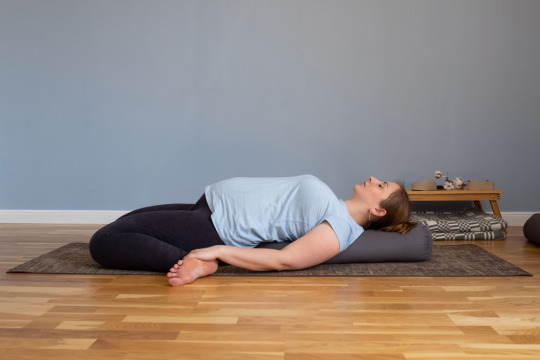
Yoga nidra is a popular form of yoga that focuses on relaxation and meditation. It is beneficial for both physical and mental health, and can be practiced by people of all ages. It is especially helpful for pregnant women as it helps to reduce stress and anxiety during pregnancy
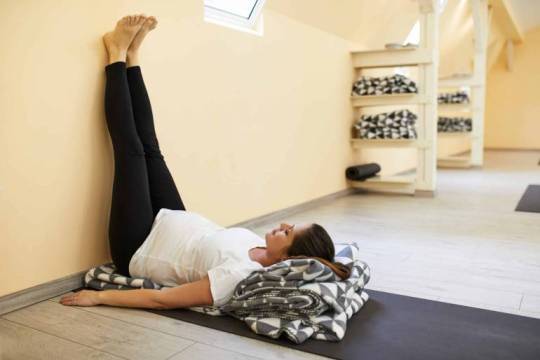
Viparita Karani, also known as Legs Up the Wall pose, is a restorative yoga pose that is beneficial for both physical and mental health. It helps to reduce stress and improve circulation in the body. The pose can be done by anyone regardless of their level of experience with yoga.

Konasana, also known as Angle Pose, is a popular yoga pose that helps to open up the hips and strengthen the legs. It is a great way to stretch the lower back and can be used in many different yoga sequences. Konasana is beneficial for both pregnant and non-pregnant individuals. It can help to alleviate lower back pain, improve balance and flexibility, increase circulation, and reduce stress. For pregnant women, it can help improve posture during pregnancy and prepare for labor.
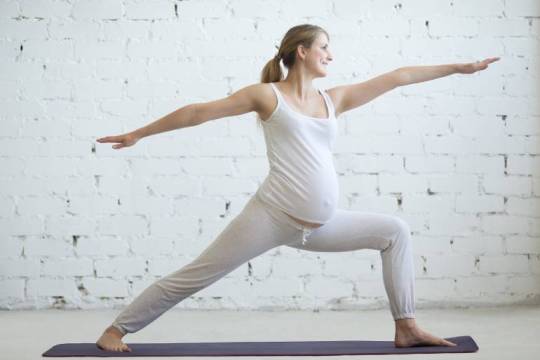
Virabhadrasana, or Warrior Pose, is one of the most popular yoga poses. It is known to be beneficial for pregnant women as it helps improve balance and strength while increasing flexibility. It is also said to help reduce stress and fatigue during pregnancy. The steps to do Virabhadrasana for pregnant women are simple yet effective. First, stand with your feet together and your hands on your hips. Then take a deep breath in before you step forward with one foot and place it firmly on the ground. After that, bend your front knee until it forms a 90-degree angle while keeping your back leg straight and strong. Finally, raise both arms above your head while keeping the core engaged and hold this pose for several breaths before releasing.
Precautions to take before yoga-
Each exercise has its own benefits and should be done with caution to avoid any potential risks. With the proper guidance from a certified yoga instructor or doctor, pregnant women can safely practice these exercises to stay fit throughout their pregnancy.
It is important to choose the right poses and trimester to ensure that you are doing yoga safely and effectively. Each trimester brings different physical changes, so it is important to know which poses are most suitable for each one.
It is important to remember that the poses that are safe for non-pregnant people may not be suitable for pregnant women. Certain poses should be avoided during pregnancy yoga as they pose safety risks such as increasing the risk of miscarriage or preterm labor. It is also important to ensure that the instructor has experience in teaching prenatal yoga classes and is aware of the safety precautions needed for pregnant women.
0 notes
Text
Quick Yoga Poses for a Refreshing Workday
Introduction
In the hustle and bustle of our modern work lives, it's easy to get overwhelmed and stressed out. Long hours at a desk, constant screen time, and the pressures of meeting deadlines can take a toll on our physical and mental well-being. That's where Live Online Yoga Classes comes in as a powerful tool to help us rejuvenate and refresh during the workday. In this blog, we'll explore some quick and easy yoga poses that you can incorporate into your daily routine to stay energized, focused, and stress-free.
1. Mountain Pose (Tadasana):
Start your workday Online Yoga Classes routine with the simple yet effective Mountain Pose. Stand with your feet hip-width apart, grounding yourself firmly into the floor. Roll your shoulders back and down, and elongate your spine. Take deep breaths, inhaling and exhaling slowly, to calm your mind and establish a sense of presence. This pose not only improves your posture but also sets a mindful tone for the day ahead.
2. Chair Pose (Utkatasana):
To combat the effects of sitting for extended periods, try the Chair Pose. Begin by standing in Mountain Pose. On your inhale, raise your arms overhead, and as you exhale, bend your knees, as if you're sitting back into a chair. Hold this position for a few breaths while keeping your core engaged and your weight evenly distributed in your feet. This pose strengthens your leg muscles and stimulates blood flow, providing a quick energy boost.
3. Cat-Cow Stretch (Marjaryasana-Bitilasana):
If you're feeling tension in your back or neck, the Cat-Cow stretch is a fantastic choice. Get down on your hands and knees, and inhale as you arch your back, lifting your head and tailbone (Cow Pose). Exhale, round your back, and tuck your chin (Cat Pose). Repeat this flow for a minute or two to relieve tension and improve spinal flexibility. It's a great way to release stress and improve posture.
4. Child's Pose (Balasana):
For a moment of relaxation and mental clarity, transition into Child's Pose. Kneel on the floor with your big toes touching and knees spread apart. Sit back on your heels and stretch your arms forward, resting your forehead on the mat. Breathe deeply and let go of any tension in your shoulders, back, and neck. Child's Pose is a restorative pose that helps calm the mind and reduce stress, making it perfect for a quick midday reset.
5. Warrior II (Virabhadrasana II):
To feel strong and grounded during your workday, try the Warrior II pose. Begin in a standing position, step one foot back, and turn it perpendicular to your front foot. Bend your front knee at a 90-degree angle and extend your arms parallel to the floor. Gaze over your front hand and take deep breaths. This pose improves concentration and builds physical and mental strength.
6. Seated Forward Bend (Paschimottanasana):
If you've been sitting for long hours, the Seated Forward Bend can help alleviate stiffness in your lower back and hamstrings. Sit with your legs extended straight in front of you, inhale to lengthen your spine, and exhale as you hinge at your hips to reach for your toes or shins. Keep your back flat and focus on your breath. This pose promotes relaxation and can help relieve stress-related symptoms.
7. Legs Up the Wall (Viparita Karani):
To recharge and combat fatigue, find a quiet space to practice Legs Up the Wall pose. Sit with your side against a wall and swing your legs up so that your body forms an "L" shape. Rest your arms by your sides, close your eyes, and take slow, deep breaths. This restorative pose improves circulation, relieves tired legs, and offers a sense of calm.
Conclusion
Incorporating these quick yoga poses into your workday can make a significant difference in your overall well-being. Even just a few minutes of practice can help reduce stress, increase energy, and improve focus. Remember to listen to your body and adjust the poses to your comfort level. Whether you're a seasoned yogi or a beginner, these poses are accessible to everyone and can be seamlessly integrated into your daily routine for a more refreshing and productive workday. So, take a break, roll out your mat, and start reaping the benefits of yoga for a healthier work-life balance. Namaste!
0 notes
Text
8 Essential Yoga Poses for Women’s Wellness
Introduction
Welcome to our comprehensive guide on the 8 essential yoga poses every woman should practice for overall wellness. At [Our Company], we are committed to providing valuable information and empowering women to enhance their physical and mental well-being through the practice of yoga. In this article, we will explore eight key yoga poses that are specifically beneficial for women, promoting strength, flexibility, balance, and inner harmony.
1. Mountain Pose (Tadasana)
Mountain Pose, or Tadasana, forms the foundation of many yoga sequences. This pose helps to improve posture, increase body awareness, and promote a sense of grounding and stability. Stand tall with your feet hip-width apart, distribute your weight evenly, and lengthen your spine. Imagine yourself rooted to the ground like a mountain, feeling a gentle lift through the crown of your head.
2. Warrior II (Virabhadrasana II)
Warrior II, or Virabhadrasana II, is a powerful standing pose that builds strength in the legs, opens the hips, and enhances focus. Start with your feet wide apart, extend your arms parallel to the floor, and turn your right foot outwards while keeping your left foot slightly turned in. Bend your right knee, aligning it over the ankle, and gaze over your right fingertips. Repeat on the opposite side.
3. Bridge Pose (Setu Bandhasana)
Bridge Pose, or Setu Bandhasana, is a rejuvenating backbend that strengthens the glutes, hamstrings, and lower back while opening the chest and shoulders. Lie on your back with your knees bent and feet hip-width apart. Press your feet into the mat, lift your hips, and interlace your fingers beneath you. Lift your chest toward your chin while keeping your neck relaxed.
4. Cat-Cow Pose (Marjaryasana-Bitilasana)
Cat-Cow Pose, a gentle flowing sequence of two poses, provides an excellent stretch for the spine and releases tension in the back and neck. Begin on your hands and knees with your wrists under your shoulders and knees under your hips. Inhale, arch your back, and lift your tailbone for Cow Pose. Exhale, round your spine, and tuck your chin towards your chest for Cat Pose. Flow between the two poses smoothly, synchronizing your breath.
5. Tree Pose (Vrksasana)
Tree Pose, or Vrksasana, helps to improve balance, concentration, and core strength. Stand tall with your feet hip-width apart and shift your weight onto your left foot. Place the sole of your right foot against your inner left thigh or calf, avoiding direct contact with the knee joint. Find a focal point and bring your hands together at your heart center. Repeat on the opposite side.
6. Child's Pose (Balasana)
Child's Pose, or Balasana, is a restorative pose that promotes relaxation, relieves stress, and gently stretches the hips, thighs, and back. Start on your hands and knees, widen your knees, and bring your big toes to touch. Sit back on your heels and lower your torso between your thighs. Extend your arms forward or alongside your body, and allow your forehead to rest on the mat.
7. Cobra Pose (Bhujangasana)
Cobra Pose, or Bhujangasana, strengthens the back muscles, stimulates the digestive system, and promotes flexibility in the spine. Lie on your stomach with your palms flat on the mat near your shoulders. Press the tops of your feet and thighs into the floor, inhale, and lift your chest off the ground using your back muscles. Keep your elbows close to your body and look forward or slightly upward.
8. Legs-Up-the-Wall Pose (Viparita Karani)
Legs-Up-the-Wall Pose, or Viparita Karani, is a restorative inversion that helps to reduce fatigue, relieve swollen ankles, and calm the mind. Sit sideways with one hip against the wall and swing your legs up, resting your heels against the wall. Lie back and adjust your position so that your hips are slightly away from the wall. Relax your arms by your sides or place your hands on your belly.
Conclusion
Congratulations! You have now discovered eight essential yoga poses that every woman should incorporate into her wellness routine. Remember to practice with mindfulness, listen to your body, and consult a qualified yoga instructor if you are new to yoga or have any underlying health conditions. Regular practice of these poses will not only enhance your physical strength and flexibility but also promote a deep sense of inner harmony and well-being.
Join us at The Pink Lotus Academia as we continue to empower women on their journey toward optimal health and self-discovery through the transformative power of yoga. Start your yoga practice today and experience the incredible benefits it can bring to your life.
Namaste!
Instagram: @thepinklotusacademia
Facebook: @thepinklotusacademia
Faculty: Kaavita Das
Enquire Now: Click Here
Yoga Mats: https://amzn.to/44FXbJ1

0 notes
Photo
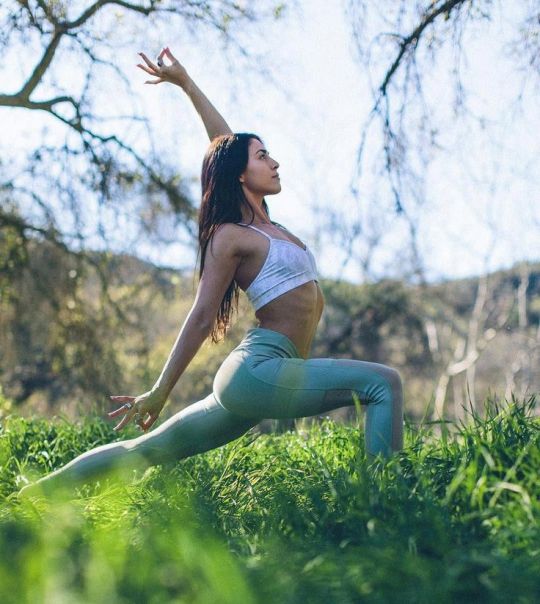
(via Yoga Tips And Strategies For advanced yoga poses step by step | Yoga photos, Yoga images, Yoga poses advanced || Curated with love by yogadaily)
#viparita virabhadrasana#yoga#yogi#yogini#yoga daily#yoga inspiration#yoga motivation#asana#asanas#yoga pose#yoga poses#fitness#health & fitness#manifestation#manifesting#manifest#Aesthetic
51 notes
·
View notes
Text

Yoga has been found to be a beneficial practice for managing depression symptoms by promoting relaxation, reducing stress, and improving overall well-being. Here are five effective yoga poses that you can do at home to help alleviate depression:
01.Child's Pose (Balasana):
Child's Pose is a gentle resting pose that promotes relaxation and introspection. Begin by kneeling on the floor, sitting back on your heels. Lower your torso forward, resting your forehead on the mat or a cushion. Extend your arms forward or alongside your body. Take slow, deep breaths and allow your body to relax, releasing any tension or stress.
02.Bridge Pose (Setu Bandhasana):
Bridge Pose helps energize the body and promote feelings of rejuvenation. Lie on your back with your knees bent and feet flat on the floor. Place your arms alongside your body, palms facing down. On an inhale, press your feet into the floor and lift your hips, creating a bridge shape with your body. Hold the pose for a few breaths, feeling the stretch in your chest and thighs. Slowly lower your hips back down to the floor.
03.Standing Forward Fold (Uttanasana):
Standing Forward Fold helps calm the mind, relieve tension, and improve circulation. Stand tall with your feet hip-width apart. On an exhale, slowly fold forward from your hips, bending your knees as needed. Let your head and neck relax, and allow your arms to hang freely or grab opposite elbows. Take deep breaths and focus on releasing any physical and mental tension.
04.Warrior II (Virabhadrasana II):
Warrior II is a grounding pose that promotes strength, stability, and a sense of empowerment. Begin in a standing position with your feet wide apart. Turn your right foot out to the side and bend your right knee, aligning it with your ankle. Stretch your arms out to the sides, parallel to the floor, with your gaze over your right hand. Hold the pose for several breaths, feeling a sense of strength and stability. Repeat on the other side.
05.Legs-Up-The-Wall Pose (Viparita Karani):
Legs-Up-The-Wall Pose is a restorative posture that helps calm the nervous system and promote relaxation. Sit with one hip against a wall and lie back, extending your legs up the wall. Relax your arms by your sides or place your hands on your belly or chest. Close your eyes, breathe deeply, and allow your body and mind to relax in this gentle inversion.
Remember, yoga is not a substitute for professional help or treatment for depression. If you are experiencing symptoms of depression, it is important to seek guidance from a healthcare professional. Yoga can be a complementary practice to support your overall well-being and mental health journey.
0 notes
Photo

For 1/8 💕• @yogafaith Congratulations on your 7 days of stillness. Keep at it, the best is yet to come! Day 8 // Jan. 8 Day 8 – Be Still Challenge Andrea Larson Meditation: Trust & Provision Posture: Reverse Warrior (Viparita Virabhadrasana) “I gave you a land on which you did not toil and cities you did not build.” Joshua 24:13 You have heard it said, “God helps those who help themselves” or something along the lines of “God can’t direct an object that isn’t moving”. Where did these thought processes come from? I believe it is rooted in a works-based mentality. Man’s incestuous relationship with his own strength. The old covenant required the Hebrews to perform in order to satisfy the law. However, the law was impossible to fulfill by man’s effort in its purest form. This impervious task was God’s attempt at showing the Hebrews their need for a Savior. A Savior who would fulfill the law and give them an abundant life they did not earn or deserve. The new and better covenant through our precious Jesus makes us rely on His work. He is our strength, He is our peace, He is our counselor, He is our provider, and the list is endless. Our “job” is to be at His feet, in relationship with Him, and listen to His still small voice we call the unction of the Holy Spirit. He will direct your steps and provide for you along the way (Phil 4:19). So, are you lacking anything? Abba provides exceedingly, abundantly above all you could ask or think. (Eph 3:20) Stop trying to do everything on your own. “For it is not by force, nor by strength, but by His Spirit. (Zec 4:6) It is then you will see the manifestation of Him in your life that you may boast of Him and not yourself. Father, thank you for the precious gift of Jesus, and for Your willingness and ability to provide for your children. Help me to hear Your voice clearly and trust Your direction for my life. You are my provider, and I am not. Guide my path that I may see clearly and allow for all endeavors to be credited to Your hand and not my own. In the name of Jesus. 📸 @michelle.thielen #yogafaith #bestillchallenge2023 #danielfast2023 (at YOGA FAITH) https://www.instagram.com/p/CnI-2OOOa_T/?igshid=NGJjMDIxMWI=
0 notes
Text


𝐑𝐞𝐯𝐞𝐫𝐬𝐞 𝐖𝐚𝐫𝐫𝐢𝐨𝐫 𝐏𝐨𝐬𝐞 - ( 𝐕𝐢𝐩𝐚𝐫𝐢𝐭𝐚 𝐕𝐢𝐫𝐚𝐛𝐡𝐚𝐝𝐫𝐚𝐬𝐚𝐧𝐚 )
Reverse Warrior Pose (Viparita Virabhadrasana) is a standing balancing pose with an incredible opening in the sides of the torso as well as stretching the legs, practiced under the variation of the Virabhadrasana series. The name comes from the Sanskrit words viparita = reverse or inverted, virabhadra = the name of a warrior created by Lord Shiva (as per Hindu Mythology), and asana = posture. In addition to strengthening the body like a warrior, this pose promotes mental focus and energizes the mind and body.
𝐁𝐞𝐧𝐞𝐟𝐢𝐭𝐬 𝐨𝐟 𝐑𝐞𝐯𝐞𝐫𝐬𝐞 𝐖𝐚𝐫𝐫𝐢𝐨𝐫 𝐏𝐨𝐬𝐞 :
★ Opens the chest and side body, releasing tension in the intercostal muscles around the ribs and allowing for a freer deeper breath. .
★ Strengthens the legs.
★ Helps with mobility in the hips and stretches the inner thighs.
Join Our : Yoga School In Rishikesh To become a Certified yoga teacher
#yoga#medizin#yogapose#yogacourses#200hryogateachertrainingrishikesh#myyogalife#yogalife#yogacourse#yogaexercise#yogapractice#yoga school in india#yogacommunity#yoga courses#yogacoach
0 notes
Text
The Fighting Warrior Pose, also known as Yudhasana, strengthens your front leg, and your back leg and stretches your foot. Angry determination, find your inner strength and warrior power, feel that your whole body is in this pose, arms, and back are strong and powerful.
🔸 🔸 🔸 🔸 🔸 🔸 🔸 🔸 🔸 🔸
🧘♂️ Information:👉
1️⃣ Known as:👉 Fighting Warrior Pose, Yudhasana
2️⃣ Sanskrit name:👉 युद्धासन
3️⃣ IAST:👉 Yudhâsana
4️⃣ Pronunciation:👉 yu-DAHS-uh-nuh
5️⃣ Level:👉 Advanced
6️⃣ Type:👉 Standing
7️⃣ Focus:👉 Entire body (Especially the legs, foot, arms, and back)
8️⃣ Total time:👉 30 to 60 seconds
9️⃣ Drishti:👉 Hastagre (hands) or Hastagrai
🔟 Chakra:👉 Swadisthana Chakra, Muladhara Chakra
💡 Indications:👉 Inner strength, legs, foot
💡 Counterposes:👉 Downward Facing Dog (Adho Mukha Svanasana)
💡 Preparatory poses:👉 Alanasana (Ashta Chandrasana or Crescent Lunge Pose), Parighasana (Gate Pose), Utkata konasana (Goddess Pose), Virabhadrasana I (Warrior I), Virabhadrasana 2 (Warrior II)
💡 Follow-up poses:👉 Utthita parsvakonasana (Extended Side Angle Pose), Viparita Virabhadrasana (Reverse Warrior Pose), Trikonasana (Triangle Pose)
💡 Contraindications:👉 High blood pressure, weak heart or heart surgery, pregnant woman (second and third trimesters), diarrhea, knee arthritis
🔸🔸🔸🔸🔸🔸🔸🔸🔸🔸
#yoga poses#Fitzabout#Fitabouts#Fighting warrior pose#Yudhasana#yoga#yogadaily#yogaeveryday#yogateacher
1 note
·
View note